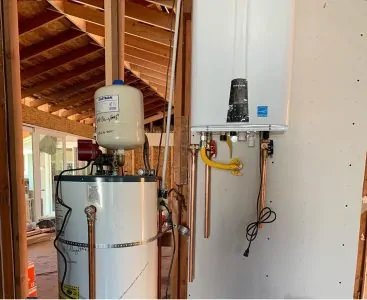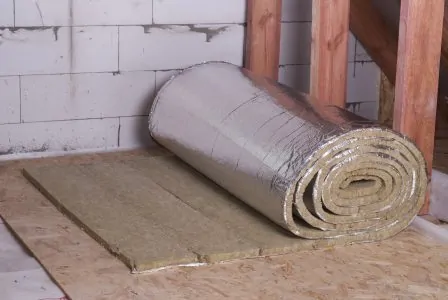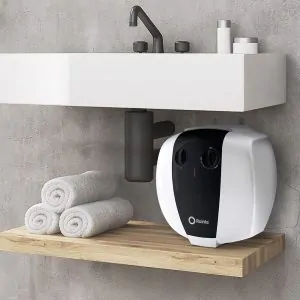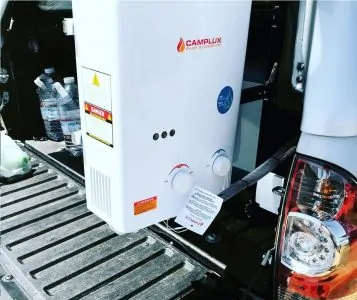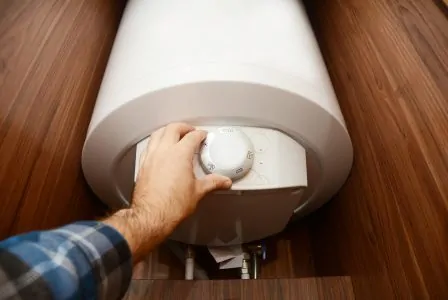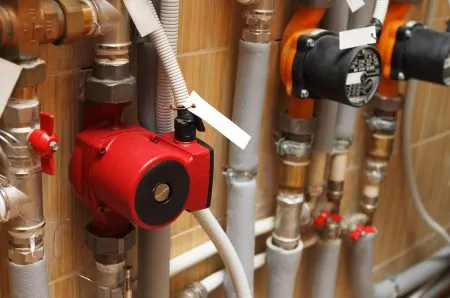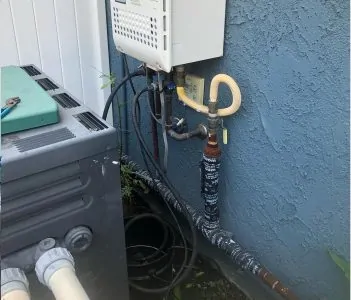What if we said you could save money on your energy bills? Or that you could replace the huge hot water tank in your basement with something far smaller? These are just some of the benefits of a tankless water heater.
Tankless water heaters provide warm water only when you need it. Many homeowners swear by them, while others are less convinced. In this article, we will compare these two popular types to get a better sense of which would be better for you: a tankless or tank water heater.
Key Takeaways
- Tank water heaters store and heat water, while tankless water heaters heat water on demand.
- Tankless water heaters are generally more energy-efficient and have a longer lifespan, but can be more expensive to install.
- Storage tank water heaters are cheaper and easier to install, but may suffer from standby heat loss and shorter lifespans.
- Consider your household’s hot water usage, available space, and budget when deciding between a tank or tankless water heater.
How They Work
Tank water heaters have been around for more than a century. It’s a tried and tested system and, if you encounter any issues, it’s easy to find someone who can help.
Tankless water heaters, on the other hand, are a more recent invention. Switching from one type to the other is more complicated than you might think. Let’s take a closer look at a tankless water heater vs tank in terms of how they function.
1. Storage Tank Water Heater
As the name suggests, storage tank water heaters consist of a water tank with heating elements inside. The tank could be many different sizes, depending on your requirements. Common sizes are 40, 50, or 80 gallons.
Tank water heaters mainly run on electricity or natural gas. Although rarer, there are models powered by solar energy or a heat pump.
Inside the tank, there is a heating mechanism. A gas-powered unit will have burners at the bottom, while an electric unit will have two electrical elements: one at the top and one at the bottom. Despite having two elements within their tank, electric units tend to heat water more slowly.
A storage tank can occupy quite a lot of space. Depending on the capacity, it could be over five feet tall and more than two feet wide.
Homeowners who store the tank in their basement may not mind the size. Not everyone has that option. Some people have to keep it in a closet, which limits their storage space.
Keep in mind that newer models are even larger than older units of equal capacity. This is due to new water heater regulations that require units to be more energy efficient.
2. Tankless Water Heater
Tankless water heaters are exactly what their name suggests. Instead of storing water in a tank, they heat water when required. They are also referred to as on-demand water heaters.
When you turn on a hot water tap in your house, the tankless unit will ignite. Then, cold water enters the system and is quickly heated as it passes through a heat exchanger.
Tankless water heaters usually run on electricity or gas, but they can also run on propane. By heating water on demand, the tankless water heater eliminates standby heat loss, which is a major drawback of tank types.
The stream of hot water from tankless heaters isn’t limited by tank capacity, but they are limited by output flow rates.
As they have no tank, a tankless water heater won’t occupy much space. The size depends on the model but they are generally about two feet tall and a little over a foot wide.
To save even more space, tankless water heaters can be mounted on a wall.
Installation and Initial Price
Tankless water heaters tend to be more expensive to buy than tank units. They are also more difficult to install, unlike a tank water heater that can usually be installed by any relatively handy homeowner. Let’s examine the difference in the installation of a tankless water heater vs traditional models.
1. Storage Tank Water Heater
Replacing your old tank water heater with a new tank is a fairly basic plumbing job. Many homeowners do it themselves. However, manufacturers always recommend hiring a professional plumber.
You can still encounter problems, especially if you switch from electric to gas. Gas water heaters require specialized vents for the exhaust, which must be installed correctly. You might also need to draw a gas line to reach the unit.
The initial outlay for an average 50-gallon tank should be under $800.
2. Tankless Water Heater
Installing a tankless water heater is less straightforward, especially if you upgrade from tank to tankless.
Gas models in particular can be quite tricky. They often require larger fittings and vents, so you will likely need to replace a few pipes.
Electric models use far more electricity than tank heaters — up to 160 amps. This might require you to upgrade your electrical circuit to 200 amps or more.
Finding a plumber to install your new tankless model can also be tricky. Most suppliers recommend using certified plumbers or electricians. Some manufacturers even require the installation to be done by a factory-trained professional for the warranty to be valid.
Tankless water heaters also command a significantly higher initial price — generally between $500 and $1,200. Paying for installation on top of that adds to the total outlay.
Energy Efficiency and Use
A water heater is an essential part of any home. However, its energy consumption is easy to overlook.
1. Storage Tank Water Heater
Heat loss is a common issue with storage tank water heaters. To maintain the water temperature in the tank, a constant supply of fuel is required, even when you’re not home. This results in a significant amount of wasted energy.
The efficiency of a tank water heater is measured by its energy factor. The higher the factor, the more efficient the unit.
The most energy-efficient water heaters earn an Energy Star, which can be seen on the label. These units generally have an energy factor of between 0.67 and 0.70.
Older water heaters (10+ years) don’t have the same insulation as newer models. If you have an older model, you could benefit from using an insulation blanket. These are fitted to the tank and help trap the heat inside.
Insulation blankets are available in various materials, including aluminum and fiberglass. It is an inexpensive way to address the problem.
A simple way to test if your water heater is losing heat is by placing your hand on the tank. If it feels warm or hot to the touch, it requires insulation (1).
It is important to purchase a tank water heater that suits your specific requirements. If you get one that is too small, it will run out of hot water too quickly. On the other hand, one that is too large will waste energy keeping unused water warm.
This is why it’s important to figure out how much hot water you use on a typical day. This estimate will give you a much better sense of your needs before buying.
2. Tankless Water Heater
Tankless water heaters are generally believed to be more energy-efficient than tank types. This is because they only turn on when needed. However, as mentioned previously, electric models use much more electricity than tank units when they are both active.
With an average hot water use of 41 gallons daily, a tankless unit can be 24% to 34% more energy-efficient than tank types. If you use more, even over 80 gallons, it will be less efficient as it requires more energy to work properly.
Tankless water heaters generally provide hot water at a rate of 2 to 5 GPM (gallons per minute). Gas-powered units usually have a higher flow rate than electric models.
The flow rate of a single tankless unit, regardless of fuel type, might not be enough for homes with high water demand. Tankless water heaters can struggle to keep up with simultaneous use as they can only heat water at a certain rate. This depends on the model and how many gallons it can heat per minute.
For homes with a high demand for hot water, it’s recommended that you install more than one unit. For a more energy-efficient home, you could install a unit at each hot water outlet. By doing this, you could save between 27% and 50% more energy than with regular tank heaters.
Multiple units can be installed in parallel connection. They combine to produce the amount of hot water you and your appliances require.
Although you avoid the problem of standby heat loss with a tankless heater, there is another issue you may face. Gas-powered units tend to waste a significant amount of energy if they have a pilot light burning constantly.
The energy used to keep the pilot light burning is sometimes as much as the standby heat loss found in tank types. This could make your gas-powered tankless unit far less energy efficient.
The operation cost of the pilot light varies from model to model. You can ask the manufacturer of the unit you’re considering for an exact number.
Not all gas-powered units use a pilot light. If yours does, you can easily turn it off when it’s not in use.
It’s recommended that you choose a unit that has an intermittent ignition device rather than a pilot light. An IID works similarly to the spark ignition you find on many gas stoves and ovens (2). This is becoming the standard method of ignition on all new models.
Lifespan and Maintenance
Buying a new water heater is a big investment, so you want to purchase a unit that will last you through at least the warranty.
1. Storage Tank Water Heater
The average life expectancy of a tank water heater is between 10 to 15 years (3). However, the actual lifespan of a tank unit depends on several factors such as manufacturer, usage, maintenance, and installation. If your unit is more than 10 years old and begins to fail, it might be best to replace it.
With tank water heaters, scale and other sediments gather at the bottom. This can negatively impact the efficiency of your unit.
Maintaining your heater is essential. To get rid of build-ups of any kind, you will need to flush the tank. You should do this by flushing a quarter of the tank every three months.
Other tasks you can carry out to increase the efficiency of your unit include checking the temperature and pressure valves. This should be done every six months to ensure everything works as it should.
It’s also essential to check the anode rod at least every three to four years (4). The anode rod is located at the top of your tank. Its purpose is to prevent the water heater from rusting.
The anode rod is one of the most important parts of your tank water heater. It is a steel core wire surrounded by metal, usually aluminum, zinc, or magnesium (5).
2. Tankless Water Heater
Tankless water heaters generally have a much longer life than storage tanks. They typically have a life expectancy of more than 20 years. They are also simpler to fix if anything goes wrong, as parts are readily available and easy to replace.
Tankless water heaters are somewhat low maintenance. As there is no water stored within the unit, sediment is slower to build up. Unfortunately, that doesn’t mean it can’t happen.
Depending on your local water — whether it’s hard or soft — it’s best to flush the system at least once a year. It’s an easy job and you don’t need any expensive tools.
All you need is a three to five-gallon bucket, a hose, and a pump. You can then use a specialized cleaning solution or white vinegar diluted with water. You can also purchase a specialized flushing kit that includes everything you need.
For people living in areas with hard water (more minerals), flushing the system once a year may not be enough (6). You might have to do it every six months or so. If you notice a decrease in your hot water flow, it could be time to flush the unit.
FAQs
A Heated Debate
Whether you should go tank or tankless is a personal choice. Although a tankless unit can be very efficient for some homeowners, it won’t be the right fit for every home.
To make using tankless water heaters more efficient, it’s recommended to add more than one. However, this won’t be cheap and could be very expensive. Consider your personal circumstances carefully before you decide on a type.
Tankless vs tank water heater — which would you choose after reading this article? Let us know your thoughts.
